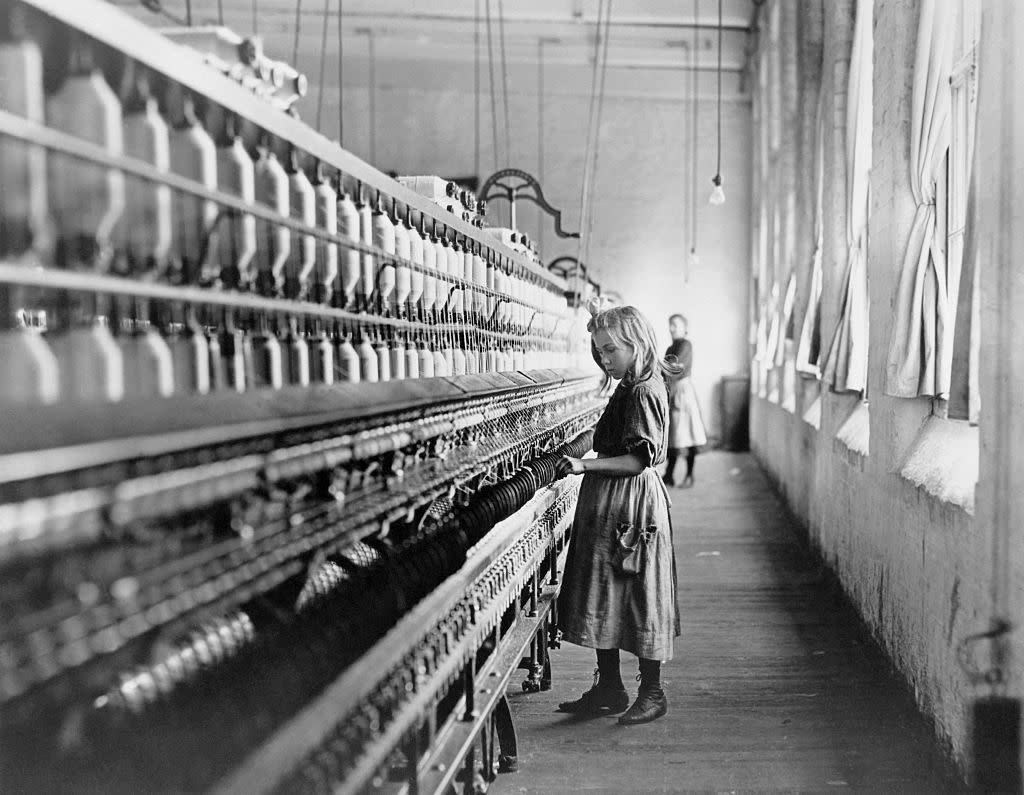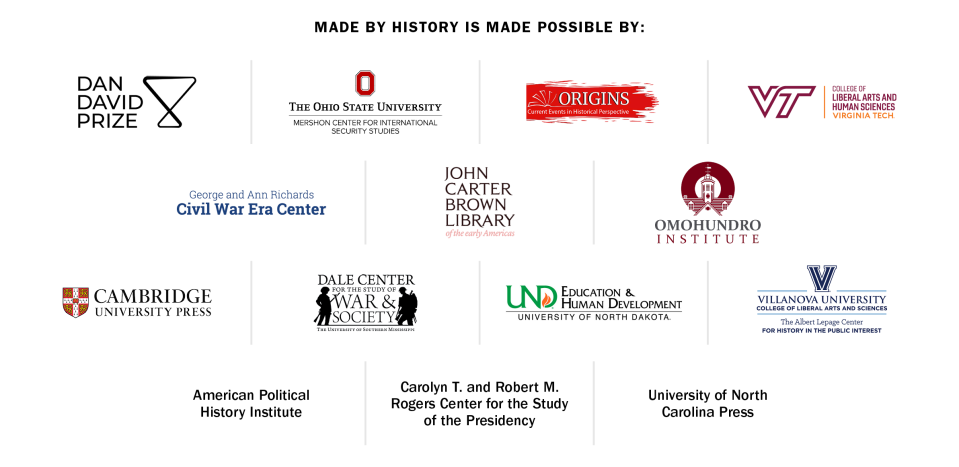The Forgotten History of the Child Labor Amendment

A young girl tends the spinning machine at a cotton mill in North Carolina. Children worked adult hours for pennies in mills and factories all over the United States until reforms came with the Fair Labor Standards Act of 1938. Credit - Bettmann Archive
Child labor protections in America are being challenged at the state level and, in some cases, reversed in ways we haven’t seen in decades. In 2022 and 2023, Arkansas, Iowa, New Hampshire, and New Jersey passed laws weakening protections for child workers. At least eight other states are considering similar laws. Most recently, Missouri is considering a bill to loosen restrictions for kids ages 14 and 15, and the Alabama Policy Institute is pushing for undoing child labor laws as a solution to Alabama's labor shortage.
Such state-level rollbacks threaten to undermine the Fair Labor Standards Act (FLSA), the basis of federal child labor protections. In response, many are now calling for strengthening FLSA enforcement by increasing federal funding for inspectors.
However, the history of this legislation points to critical weaknesses in its framework. An alternative proposal that was considered at the time but that failed to pass, the Child Labor Amendment, would have forged much greater protections.
Many assume that the movement to abolish child labor in America was a straightforward march toward progress that culminated in the 1938 passage of the FLSA. In reality, the history of U.S. child labor regulation was a contentious battle that began with industrialization efforts in the post-Civil War South. Every step of the way, opposition backed by big business thwarted reformers' efforts to limit or abolish child labor.
Read More: Over 100 Kids Were Illegally Employed in Dangerous Meat-Packing Plant Jobs
By 1900, more than 1.75 million American children under the age of 15 worked for wages in industrial jobs. Ten years later, the total surpassed 2 million. That was more than 1 in 5 children under the age of 15.
These were low estimates since they did not include children working in agriculture or children working for their own families. A 1922 study of seasonal demand for farm labor in Virginia, Maryland, and New Jersey found that three-fifths of white children and nearly three-fourths of Black children were working before the age of 10.
The direness of the child labor situation prompted many individuals across the country to band together in support of a Child Labor Amendment. An amendment to the Constitution would empower Congress to "protect all children in all parts of the country alike."
In this effort, reformers gained the support of many new allies including teachers' federations, women's clubs, religious organizations, labor unions, and African American reformers. The movement to abolish child labor had been overwhelmingly led by white reformers since the 1870s, when the growing problem of poor white children working in Southern textile mills launched the issue onto the national stage.
But the movement to regulate child labor became more diverse in the 1920s. African American reformers saw the amendment's potential to give Congress authority to protect Black children and youth, especially at a time when they were trying to secure anti-lynching legislation. As the Chicago Defender put it in 1924, "the mob doctrine" is what permitted the "barbarities" of both lynching and child labor to continue unimpeded in the South. Thus, editors wrote, "we are heartily in favor of the proposed amendment."
Labor unions took a special interest in child labor and opposed it because it threatened to reduce adult workers’ bargaining power. “America must find a way to abolish completely child labor,” American Federation of Labor (AFL) President Samuel Gompers wrote in 1922. Gompers reasoned that Prohibition activists had recently secured the 18th Amendment, and women had gained suffrage through the 19th Amendment because these issues were “a matter of national concern.” Child labor, he argued, was “an equally important issue and of equal concern to the nation as a whole.” Thus, a Child Labor Amendment should be “the final endeavor to emancipate childhood.”
Riding a wave of public recognition and endorsements, reformers set their sights on amending the U.S. Constitution. After much debate the House and Senate approved the amendment in 1924. As reformers worked to get states to ratify the Amendment, child labor became one of the most debated political issues of the summer.
Unfortunately, business groups drummed up opposition to the amendment, causing it to lose momentum by 1925. While advocates continued to fight for states to ratify it well into the 1930s, by the time of President Franklin Delano Roosevelt’s presidency, they had accepted defeat.
Read More: Why Millions of Girls Are Doing Unpaid Care Work This Summer
When the Great Depression engulfed America in a severe economic crisis, reformers saw an opportunity to have child labor regulations included as part of FDR’s emergency recovery provisions. FDR strongly supported the addition of child labor regulations as part of his Fair Labor Standards Act (FLSA), which was primarily a minimum-wage and maximum-hours measure for adult workers, designed to improve pay and working conditions.
The U.S. Children’s Bureau estimated that the new law would touch “only one-fourth of child labor in the United States.” Reformer Grace Abbott, a social worker who had served as director of the child labor division of the U.S. Children's Bureau from 1917 to 1919 was devastated, calling it a “mines and factories bill” that did not protect all children in all parts of the country.
She was right. Applicable only to “shipment in interstate commerce goods produced in establishments where oppressive child labor conditions have prevailed within 30 days prior to shipment,” the FLSA exempted large swaths of child labor such as tenement houses, street trades, movies, retail, communications, and transportation. It also exempted “children under 16 employed in agriculture” and “children working for their parents in any occupation other than manufacturing or mining.”
The Christian Science Monitor called it a “conservative measure,” because it only forged minimal protections.
Once the FLSA was upheld by the Supreme Court in 1941, the public narrative about child labor reform became one of “victory.” Any public memory of the Child Labor Amendment battle, which would have forged much stronger protections, was forgotten.
Read More: Tipping Is Out of Control. It's Also a Serious Labor Issue
In the United States today we are where we are in part because of this failure. There are vulnerabilities in the FLSA that have led to large swaths of child labor going un- or under-regulated, such as in agriculture. The selective nature of the FLSA has shaped the landscape of child labor regulation for generations of young people in the U.S. And now, many states want to roll back the limited protections that do exist.
Today’s challenges would be familiar to the reformers who fought for the Child Labor Amendment a century ago and lost, and who accepted the FLSA as a consolation prize. They had to deal with similar setbacks for decades and they would be devastatingly familiar with a pro-business Supreme Court likely to undo federal child labor regulations if given the chance.
And yet the possibility remains of dusting off the Child Labor Amendment and giving it another go. As of 1937, 28 states had ratified it, ten short of the 38 needed for ratification. States that rejected the Child Labor Amendment in the early 20th century may vote differently today, such as Massachusetts, Connecticut, Vermont, Delaware, and Maryland. New York, Rhode Island, and of course Hawaii, not a state until 1959, never took action on the proposed amendment. Voters in other states may also wish to strengthen protections against child labor.

To “protect all children in all parts of the country” today’s advocates could pick up where reformers left off and amend the Constitution “to empower Congress to regulate the labor of children under the age of 18.” Such an action could be a preemptive strike against a Supreme Court poised to unravel the regulatory framework established during the New Deal.
Empowering Congress to regulate children’s labor under an amended U.S. Constitution could lay the foundations for a consistent federal standard that prioritizes children’s rights at a critical moment when business interests are gaining ground. The people’s representatives could enact a national standard that closes loopholes and exceptions, righting a 100-year wrong that has been allowed to stand for far too long.
Dr. Betsy Wood is a historian and author of Upon the Altar of Work: Child Labor & the Rise of a New American Sectionalism. Dr. Wood has received national attention for her work on child labor in America and has been regularly interviewed by major media outlets on this topic. She is a professor of American history at Bard Early College in Newark, NJ, a satellite campus of Bard College.
Made by History takes readers beyond the headlines with articles written and edited by professional historians. Learn more about Made by History at TIME here. Opinions expressed do not necessarily reflect the views of TIME editors.
Write to Made by History at madebyhistory@time.com.

